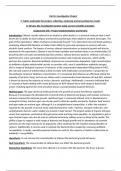Unit 6: Investigative Project
C: Safely undertake the project, collecting, analysing and presenting the results
D: Review the investigative project using correct scientific principles
Assignment title : Project Implementation and Review
Introduction: Ethanol, usually referred to as alcohol or ethyl alcohol, is a chemical molecule that is well-
known for its ability to clean surfaces and become psychotropic when added to alcoholic beverages. The
goal of this experiment, "Effect of ethanol on Bacterial Growth," is to determine how well hand sanitisers
containing ethanol kills bacteria or hinders their ability to grow and reproduce in contrast with non-
alcoholic hand sanitiser. The impact of various ethanol concentrations on bacterial growth will also be
examined in this experiment. Ethanol is used in hand sanitizer and medical wipes as an antimicrobial. By
dissolving their cell walls and denaturing their proteins, ethanol destroys bacteria. Without a cell wall, a
bacterial cell is more vulnerable to environmental moisture and molecular pressures, which swiftly
destroys the organism. Bacterial antibiotic responses are concentration-dependent. High concentrations
of antibiotics display antimicrobial activity on sensitive cells, even if subinhibitory antibiotic dosages
elicit a range of biological responses in bacteria. In the concentration-dependent killing pattern (MIC),
the rate and volume of antimicrobial activity increase with medication concentration in proportion to
the pathogen minimum inhibitory concentration. It is recognised that ethanol can effectively attack the
majority of bacteria, fungi, and viruses. When used in concentration levels between 60 and 85%, ethanol
is known to destroy the majority of viruses, bacteria, and fungi. Additionally, a research indicated that
15 seconds of hand rubbing with a hand gel based on 85% ethanol had a wide range of bactericidal
action, including against the most prevalent species causing hospital-acquired illnesses.
Nutrient agar: The agar universal media promotes the growth of several non-fibrous organisms.
Because it encourages the development of several kinds of bacteria and fungus and includes numerous
nutrients required for bacterial growth, nutritional agar is commonly utilised. Prior to biochemical or
serological testing, nutrient agar can also be used to check for quality and purity. Peptone, beef extract,
and agar make up nutrient agar. Although it is a straightforward composition, it offers the nutrients
required for the growth of several easily replicated bacteria. Salts, vitamins, nitrogen molecules, and
carbohydrates that are water soluble are present in beef extract. The largest supply of organic nitrogen
comes from peptones, particularly through amino acids and long-chain peptides. An ingredient in gels is
agar. Nutrient agar may also be used to cultivate bacteria by adding serum or blood to the media. The
ability of agar to support a wide range of bacteria and fungal growth and its abundance of essential
nutrients are the main reasons for its popularity. often employed for the isolation and purification of
cultures. Additionally, it may be used to cultivate the bacterial flora needed for assessing antibiotic
susceptibility. In reality, specially prepared media are used for the majority of studies to determine an
antibiotic's susceptibility.
Hypothesis: As we increase the concentration of ethanol the bacterial growth decreases.
Null Hypothesis: The concentration of ethanol does not affect the bacterial growth.
Alternative hypothesis: The more time ethanol is in contact with the bacteria, the lesser it grows.





